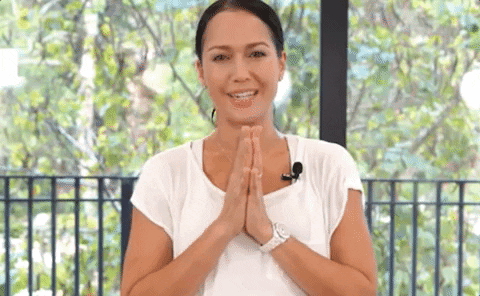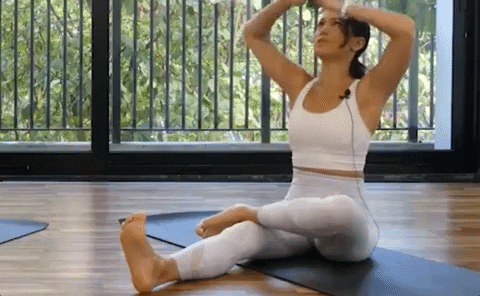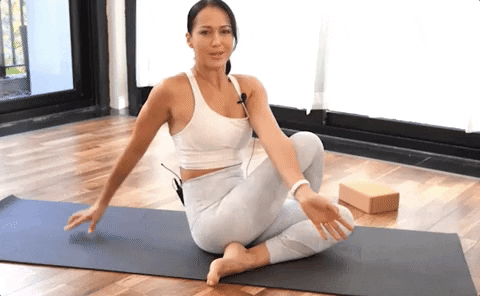
International Yoga Day is 21st June 2021, and it serves as a fantastic reminder for people who have been meaning to discover all the advantages of yoga.
According to the International Yoga Federation, 300 million people do yoga around the world. This includes about 460,000 in the UK. These numbers aren’t shocking, considering all the benefits yoga has to offer. Yoga is fun, effective, and healthy for the body and mind. It’s great for relieving stress, keeping you both toned and limber, and even helping you sleep better.
Anyone can benefit from introducing yoga into their lives. The fact that yoga has so many health benefits is one of the many reasons it’s celebrated each year on International Yoga Day.
What is International Yoga Day?

International Yoga Day is a day dedicated to celebrating all the benefits of yoga.
Yoga represents one of the most popular forms of relaxation and exercise in the world. For centuries, this unique activity has helped people find balance (both emotionally and physically.) Even better, it’s something we can all do wherever we are. If the pandemic made it difficult for you to get out into the world or visit the gym regularly, you could easily do yoga at home. If you’re on vacation, you can easily do yoga at the beach. People often learn yoga poses via yoga classes or YouTube videos, and then they practice yoga at home, at the park or at the beach.
Yoga is also something that anyone can approach in their own time, and with their own needs in mind. You don’t have to jump straight into bending over backwards in the most acrobatic of poses. Starting slowly with things like breathing exercises, gentle stretches, and simple yoga poses is enough. Eventually, you’ll notice your yoga skills improve as your body becomes more flexible and adaptable.
Let’s explore some of the benefits of using this International Yoga Day as your excuse to dive into all the benefits of yoga:
What are the Main Benefits of Yoga?
Yoga is a highly accessible form of exercise, perfect for people who want to get more movement into their lives. It’s also an extremely adaptable practice. If you’re looking to achieve specific goals with yoga, we’d recommend starting with a DNA test.
Knowing how your body works from a metabolic perspective will make it easier to determine what kind of yoga poses will help you tone, burn calories, or improve endurance. Having a specific strategy is crucial with yoga because there are so many benefits you can target with yoga.
Let’s look at some of the primary advantages of yoga:
Yoga Reduces Stress and Anxiety

Yoga is fantastic at promoting relaxation and easing stress (something we’ve all needed lately). Countless studies show it reduces the secretion of cortisol (the stress hormone). Research also indicates that yoga can help with conditions like panic and anxiety, promoting good mental health.
In one report following women with post-traumatic stress disorder, 52% of participants no longer met the criteria for PTSD at all after 10 weeks of yoga. While experts are still researching where these amazing benefits come from, it’s safe to say that yoga makes you feel good.
Better Heart Health and Reduced Inflammation
Inflammation is a side effect of many of the physical health issues people experience today. While inflammation is a natural immune response in moderation, chronic inflammation can lead to the development of pro-inflammatory diseases like cancer and diabetes.
One study found that participants who practice yoga regularly are less likely to have high inflammatory markers. This result of lower inflammation could have a serious impact on cardiac health too. One study found participants over 40 years of age who practised yoga for five years had a lower pulse and blood pressure rate than those who didn’t.
Some studies also suggest that incorporating yoga as part of a healthy routine can reduce the chances of heart disease. If heart problems run in your family, yoga is worth your time.
Better Quality of Life
Yoga just makes life better – the science proves it. For example, one study with 135 seniors stated that they used yoga and walking as regular activities. The participants were determining which activity would reduce fatigue and improve their mood. Yoga came out on top by improving happiness levels across all participants. Yoga can also help with invigoration and relaxation, and it deals with Stress, as mentioned above, which can be detrimental to the quality of life.
Studies also show that yoga may be effective at fighting depression. All forms of exercise are useful in mental health, but yoga is particularly good at relaxation and mindfulness promotion. These tools could be extremely valuable in dealing with depression.
Less Pain and Better Sleep

Chronic pain is a serious problem for millions of people worldwide, but yoga could help to manage it. Studies demonstrate that yoga and mindfulness are valuable in helping patients to control pain. One study on patients with carpal tunnel syndrome found that yoga was more effective than wrist splinting in reducing pain and enhancing grip strength.
Yoga also assists in delivering a better night’s sleep, which is crucial for anyone who wants to feel their best. Poor sleep quality is often associated with high blood pressure, obesity, depression, and other disorders. However, yoga helps us to fall asleep faster, rest for longer, and feel more well-rested the next day too.
Improved Flexibility, Strength, and Balance
Most people who put yoga to the test are looking for a way to improve their balance and flexibility. There’s considerable research to show that yoga is excellent for these goals. It’s all about helping you to use your body effectively, after all.
One report looked at the impact of 10 weeks of yoga on college athletes. Doing yoga improved the flexibility and balance of the participants in a range of ways. Experts now say that even only 15 to 30 minutes of yoga per day could be enough to upgrade your balance and flexibility.
Yoga also has a positive influence on Stress. One study found that after doing sun salutations every day for 24 weeks, participants had a massive increase in endurance, upper body strength, and weight loss.
Better Breathing and Eating Habits

One of the first things you’ll learn in yoga is how to breathe correctly. Pranayama, or yogic breathing, controls your breathing to improve relaxation and mindfulness. This practice can also build endurance and optimise performance for people in the sporting world.
Breathing skills learned in yoga can help regulate the nervous system and regulate anxiety.
Yogic breathing can even improve symptoms of asthma and lung function, according to one study. It’s not just breath you can manage more effectively either.
Mindful eating is also enhanced with yoga practices. Learning how to make the most of your food will help you to control things like blood sugar, weight loss, and poor eating behaviours. Because yoga focuses on mindfulness, it can teach you how to make the most of your eating habits. According to one study, yoga can even reduce episodes of binge eating.
Can Anyone Do Yoga?
Before you start any new health and fitness strategy, it’s a good idea to talk to a professional. If you’re prone to issues with your joints, you might find you struggle to do some forms of yoga. Your doctor may also recommend avoiding certain poses depending on whether you’ve recently had an injury or you’re recovering from surgery.
For the most part, however, yoga is like running – once you get started, anyone can do it.
Yoga is highly versatile because it comes in a lot of different styles. Hatha yoga classes are great for beginners because they’re all about slower movements. Vinyasa, or power yoga classes are more challenging, while Iyengar yoga focuses on proper alignment and balance.
Here are some quick tips to set you on the right path.
1. Start With Breathing Techniques

Mindfulness and careful breathing are two of the central pillars of any yoga practice.
If you’re keen to start practising yoga but don’t know where to start, focus on your breathing patterns first. There are tons of videos that can help you with more mindful breathing. One option called “Nadi Shodhana” is a kind of breathing designed to make you feel calm.
To practice this breathing, you’d inhale deeply through one nostril while holding the other closed. When you reach the end of the inhalation, you release the nostril and slowly exhale. Go back and forth between each nostril, taking each breath in fully to fill your chest, then exhaling gradually.
2. Stock Up On Supplies
You don’t need any advanced equipment to get involved with yoga. You can use a yoga mat (or access one at the gym if you’re taking a class). If you don’t have a mat, just make sure you have a comfortable, flat space where you can practice your poses.
As you work on new yoga strategies, you might begin to use certain props like belts, blocks, and blankets. However, most of the time, you’ll be able to find variations of what you need around the home. Yoga is one of the more affordable exercises to practice.
Make sure you have a set of comfortable clothing to wear when practicing yoga too. You want something that’s going to keep you cool and comfortable without restricting your movement.
3. Try Simple Poses
Finally, you can begin to test your skills on some simple poses.
There are plenty of options to choose from, starting with the child’s pose, downward-facing dog, and even the warrior pose. The best way to practice yoga poses is with the help of an instructor. Many YouTube channels walk beginners through the various yoga poses so that newbies can learn how it’s done.
Below are a few demonstrations from Ankie Beilke walking you through some of the simplest poses for beginners to perform wherever they are. The poses laid out in the video are:
· The Double Pigeon

This pose is perfect for those of you who have tight hips. Sit on the floor with your legs straight out in front of you. Bend your left knee, and place your knee, shin, and foot on the floor so they’re parallel with your pelvis. Stay here for five breaths, slowly release, and then switch legs so your left knee is on top.
· The Pigeon

The pigeon pose is an excellent hip opener. Bring your right knee to your right wrist. Slide your left leg back and point your toes. As you exhale, walk your arms forward and lower your upper body towards the floor. Rest your forearms and forehead on the mat. Repeat on the other side.
· The Seated Spinal Twist

Hook your left arm around your bent right knee. With each exhale, twist your torso further to the right. Repeat pose on the other side.
Celebrate the Power of Yoga
Now you know more about the benefits of yoga, and hopefully, you’ll start incorporating it into your life. Don’t worry if you’re reading this after International Yoga day is over. You don’t need an excuse to start a practice that will have you looking and feeling your best. Remember, if you need help figuring out where to begin with your yoga efforts, reach out today for your customised guidance based on your genetics, from CircleDNA.
Key in our promo code “CIRCLE25” to get a 25% discount on Circle kits!





